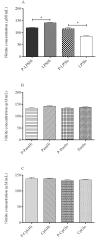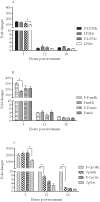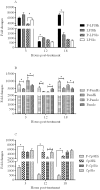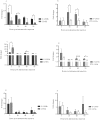Characterization of Innate Responses Induced by PLGA Encapsulated- and Soluble TLR Ligands In Vitro and In Vivo in Chickens
- PMID: 28045984
- PMCID: PMC5207720
- DOI: 10.1371/journal.pone.0169154
Characterization of Innate Responses Induced by PLGA Encapsulated- and Soluble TLR Ligands In Vitro and In Vivo in Chickens
Abstract
Natural or synthetic Toll-like receptor (TLR) ligands trigger innate responses by interacting with distinct TLRs. TLR ligands can thus serve as vaccine adjuvants or stand-alone antimicrobial agents. One of the limitations of TLR ligands for clinical application is their short half-life and rapid clearance from the body. In the current study, encapsulation of selected TLR ligands in biodegradable poly(D,L-lactide-co-glycolide) polymer nanoparticles (PLGA NPs) was examined in vitro and in vivo as a means to prolong innate responses. MQ-NCSU cells (a chicken macrophage cell line) were treated with encapsulated or soluble forms of TLR ligands and the resulting innate responses were evaluated. In most cases, encapsulated forms of TLR ligands (CpG ODN 2007, lipopolysaccharide and Pam3CSK4) induced comparable or higher levels of nitric oxide and cytokine gene expression in macrophages, compared to the soluble forms. Encapsulated CpG ODN, in particular the higher dose, induced significantly higher expression of interferon (IFN)-γ and IFN-β until at least 18 hr post-treatment. Cytokine expression by splenocytes was also examined in chickens receiving encapsulated or soluble forms of lipopolysaccharide (a potent inflammatory cytokine inducer in chickens) by intramuscular injection. Encapsulated LPS induced more sustained innate responses characterized by higher expression of IFN-γ and IL-1β until up to 96 hr. The ability of TLR ligands encapsulated in polymeric nanoparticles to maintain prolonged innate responses indicates that this controlled-release system can extend the use of TLR ligands as vaccine adjuvants or as stand-alone prophylactic agents against pathogens.
Conflict of interest statement
The authors have declared that no competing interests exist.
Figures





References
-
- Medzhitov R, Preston-Hurlburt P, Kopp E, Stadlen A, Chen C, Ghosh S, et al. MyD88 is an adaptor protein in the hToll/IL-1 receptor family signaling pathways. Mol Cell. 1998;2: 253–258. - PubMed
MeSH terms
Substances
LinkOut - more resources
Full Text Sources
Other Literature Sources

